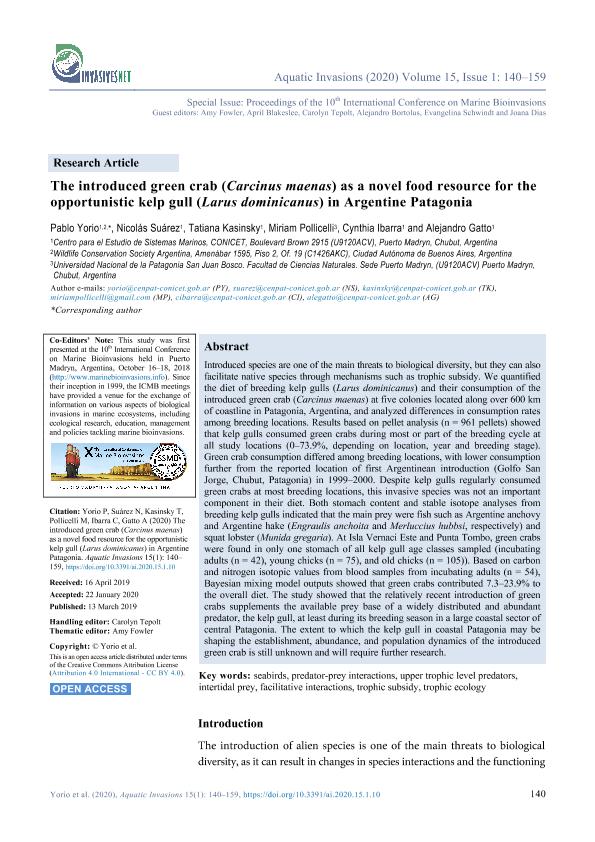Artículo
The introduced green crab (Carcinus maenas) as a novel food resource for the opportunistic kelp gull (larus dominicanus) in argentine patagonia
Yorio, Pablo Martin ; Suarez, Nicolas Marcelo
; Suarez, Nicolas Marcelo ; Kasinsky Aguilera, Lorna Tatiana
; Kasinsky Aguilera, Lorna Tatiana ; Pollicelli, Miriam; Ibarra, Cynthia
; Pollicelli, Miriam; Ibarra, Cynthia ; Gatto, Alejandro Javier
; Gatto, Alejandro Javier
 ; Suarez, Nicolas Marcelo
; Suarez, Nicolas Marcelo ; Kasinsky Aguilera, Lorna Tatiana
; Kasinsky Aguilera, Lorna Tatiana ; Pollicelli, Miriam; Ibarra, Cynthia
; Pollicelli, Miriam; Ibarra, Cynthia ; Gatto, Alejandro Javier
; Gatto, Alejandro Javier
Fecha de publicación:
03/2020
Editorial:
Regional Euro-Asian Biological Invasions Centre
Revista:
Aquatic Invasions
ISSN:
1798-6540
e-ISSN:
1818-5487
Idioma:
Inglés
Tipo de recurso:
Artículo publicado
Clasificación temática:
Resumen
Introduced species are one of the main threats to biological diversity, but they can also facilitate native species through mechanisms such as trophic subsidy. We quantified the diet of breeding kelp gulls (Larus dominicanus) and their consumption of the introduced green crab (Carcinus maenas) at five colonies located along over 600 km of coastline in Patagonia, Argentina, and analyzed differences in consumption rates among breeding locations. Results based on pellet analysis (n = 961 pellets) showed that kelp gulls consumed green crabs during most or part of the breeding cycle at all study locations (0–73.9%, depending on location, year and breeding stage). Green crab consumption differed among breeding locations, with lower consumption further from the reported location of first Argentinean introduction (Golfo San Jorge, Chubut, Patagonia) in 1999–2000. Despite kelp gulls regularly consumed green crabs at most breeding locations, this invasive species was not an important component in their diet. Both stomach content and stable isotope analyses from breeding kelp gulls indicated that the main prey were fish such as Argentine anchovy and Argentine hake (Engraulis anchoita and Merluccius hubbsi, respectively) and squat lobster (Munida gregaria). At Isla Vernaci Este and Punta Tombo, green crabs were found in only one stomach of all kelp gull age classes sampled (incubating adults (n = 42), young chicks (n = 75), and old chicks (n = 105)). Based on carbon and nitrogen isotopic values from blood samples from incubating adults (n = 54), Bayesian mixing model outputs showed that green crabs contributed 7.3–23.9% to the overall diet. The study showed that the relatively recent introduction of green crabs supplements the available prey base of a widely distributed and abundant predator, the kelp gull, at least during its breeding season in a large coastal sector of central Patagonia. The extent to which the kelp gull in coastal Patagonia may be shaping the establishment, abundance, and population dynamics of the introduced green crab is still unknown and will require further research.
Archivos asociados
Licencia
Identificadores
Colecciones
Articulos(CESIMAR)
Articulos de CENTRO PARA EL ESTUDIO DE SISTEMAS MARINOS
Articulos de CENTRO PARA EL ESTUDIO DE SISTEMAS MARINOS
Citación
Yorio, Pablo Martin; Suarez, Nicolas Marcelo; Kasinsky Aguilera, Lorna Tatiana; Pollicelli, Miriam; Ibarra, Cynthia; et al.; The introduced green crab (Carcinus maenas) as a novel food resource for the opportunistic kelp gull (larus dominicanus) in argentine patagonia; Regional Euro-Asian Biological Invasions Centre; Aquatic Invasions; 15; 1; 3-2020; 140-159
Compartir
Altmétricas



